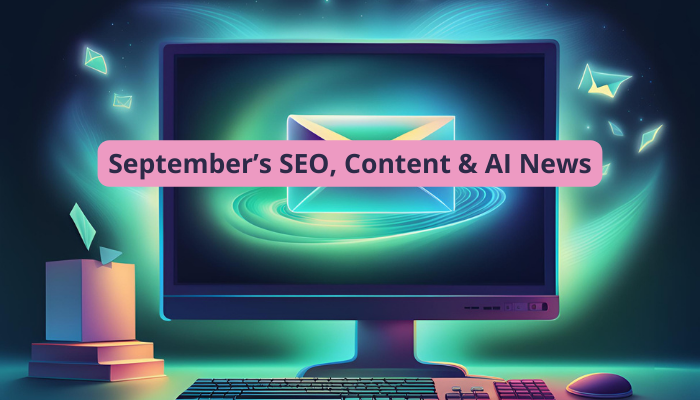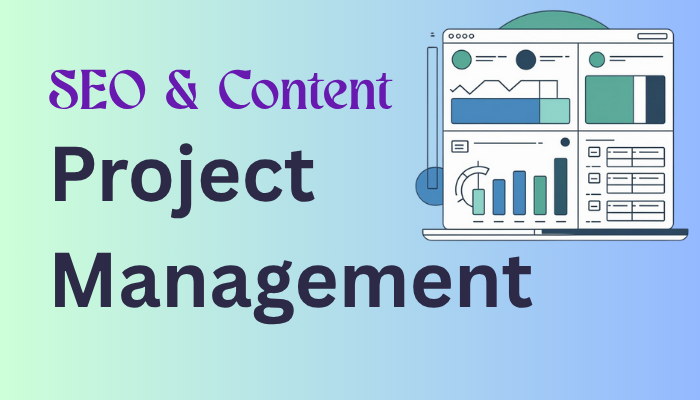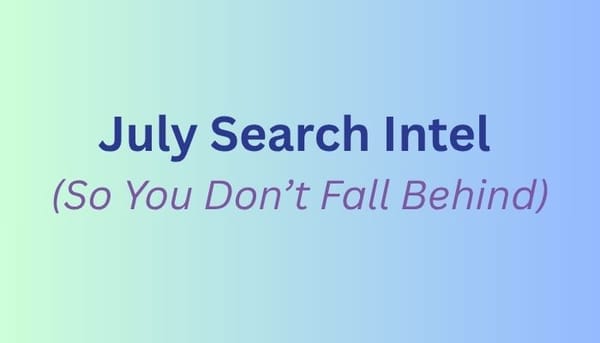Google Gets Stricter, AI Gets Pickier, and You Get the Playbook

Your MarketingAI’d update on the SEO, content, and AI trends shaping how you work (and win)
For paid subscribers: I’ve added a customized AI Optimization checklist, and 2 exclusive AI prompts designed to uncover low-hanging fruit and boost visibility in AI-driven search.
August Updates, and what this means for you
Google’s August 2025 updates put even more weight on experience and intent. Sites that load fast, work smoothly on mobile, and provide depth around a topic are gaining ground. Keyword stuffing continues to lose traction, while content that’s structured for questions, voice search, and AI overviews is being rewarded.
The other shift is around AI content itself. Google isn’t punishing it outright, but sloppy outputs are getting buried. Accuracy, originality, and authority are the deciding factors. In short: the updates are less about “is it AI or not?” and more about “does this content serve the user in the clearest, most reliable way possible?”
For SEOs, the takeaway is simple: treat AI as a drafting tool, but edit like your ranking depends on it—because it does.
Action Steps You Can Take Now:
- Audit your content for depth, accuracy, and whether it fully addresses user intent.
- Prioritize technical performance—optimize mobile experience and Core Web Vitals.
- Structure intros and headings to mirror how voice and AI search engines look for answers.
- Review your AI-created content. Make sure it’s not just generated—but curated and credible.
What the latest research says about AI and SEO
AI is creeping into people’s search habits, but it’s not dethroning Google anytime soon. SparkToro’s latest data shows 40% of Americans now use AI tools monthly and 20% use them heavily—yet growth is slowing, and traditional search remains rock-solid with 95% monthly use. NNG’s research backs this up from the UX side: even when AI answers show up, people still default to search engines out of habit and often click through to content anyway.
Meanwhile, Google is also noting that AI Overviews and its new AI Mode are driving more queries and higher-quality clicks, not fewer. People are asking more complex questions, and when they do click through, those visits are more engaged than before.
And now, new research from Previsible shows another piece of the puzzle: traffic referrals from AI platforms themselves (ChatGPT, Gemini, Perplexity, Claude, Copilot) are up 527% since January. For some SaaS companies, LLMs now account for over 1% of sessions. That’s still small compared to search, but it signals AI is becoming an additional discovery channel—not a replacement.
And yet, Conversion Media’s reporting on Ahrefs data shows the cost of these shifts: when AI Overviews appear, CTR for the top organic results drops by ~34.5 %. Being #1 no longer guarantees the same traffic—it depends on whether a summary is taking up space above the fold.
The pattern is clear: AI isn’t replacing search, it’s layering on top of it. Users treat AI as a shortcut or supplement, while search engines remain the foundation. For SEOs, that means the job doesn’t change: keep showing up where the searches happen, and make sure your content is structured to both rank in SERPs and feed into AI summaries.
Paid subscribers, get a detailed AI Optimization checklist here:
AI Search Can’t See Your JavaScript — and That Could Be Costing You Visibility
Glenn Gabe’s latest research shows that most AI search platforms—ChatGPT, Perplexity, Claude, and others—can’t render JavaScript. If your site relies on client-side rendering, these tools often see nothing, which means your content won’t appear in AI-generated answers or summaries.
Google and Bing are the exception. Because AI Overviews and AI Mode build on their existing infrastructure, they do render JavaScript effectively. That means your site may look fine in traditional search results but still be invisible to standalone AI tools.
The fix is straightforward: test your site with JavaScript disabled, or run your URLs through AI tools and see what they can read. If your content disappears, it’s time to move critical elements—like text, headings, and metadata—into server-side rendering or ensure they’re present in the initial HTML load.
Why this matters: AI search is already surfacing as a discovery channel. If your content is hidden behind JavaScript, you’re invisible where users are starting to look.
When writing content, make sure it’s skimmable
Studies show people only focus for about 47 seconds, and AI models also put the most weight on the start and end of text. Neither “reads” in the traditional sense—they both skim. That means the same rules work for both: lead with the full answer in your intro, front-load key points in each section, and keep text easy to scan with short blocks and clear cues. Content written this way serves readers better and is more likely to be cited by AI.
Action Steps You Can Take Now:
- Put your main point in the first 150 words.
- Use inverted pyramid style: start strong, then add context.
- Break text visually every 200–300 words.
- Signal importance with phrases like “The key takeaway is…”
Considering freelance our in-house? Here are 2025 salary comparisons
A new SE Ranking study on SEO salaries shows that freelancing isn’t always the gold rush people imagine—it depends where you live and how you work. Globally, freelancers make a bit more than in-house SEOs, but in the U.S. the advantage flips—employees come out ahead. The big winners are part-time freelancers, who can sometimes out-earn full-time in-house staff while working fewer hours.
The tradeoff is stability: in-house SEOs are more likely to get steady raises, while freelancers see more extreme outcomes—some struggle, a few break into the $150K+ bracket. Job satisfaction trends higher for freelancers, but stress levels aren’t lower; they’re just different.
The takeaway? The “best” path isn’t universal. Freelance SEO can deliver flexibility and higher upside, but in-house roles still provide consistency, career ladders, and reliable pay growth. It comes down to whether you want security or freedom—and how much risk you’re willing to carry.
How ChatGPT Really Ranks Content (Leaked in Plain Sight)
Metehan Yesilyurt dug into ChatGPT’s actual source config and found the files that decide which sites it cites. The findings flip a lot of SEO assumptions on their head:
- Freshness is hard-coded. Old “evergreen” guides are losing to newer posts because ChatGPT literally prioritizes recent content. Quarterly updates aren’t optional anymore.
- Intent matters. The system checks whether content clearly signals what it is—definition, tutorial, comparison—so muddy framing gets buried.
- Expert language wins. ChatGPT’s filters reward correct technical terms, not keyword stuffing. Precision = credibility.
- Neural reranking runs the show. Even if you land in results, the “ret-rr-skysight-v3” model reshuffles everything. Survival depends on actual quality.
- Different rules for private vs. public. Connected services like Dropbox get lightweight scoring, but the public web faces the full reranking gauntlet.
The takeaway: You’re not just optimizing for Google anymore, you’re optimizing for a multi-stage AI pipeline. Tricks won’t cut it. Staying fresh, authoritative, and intentional will.
AI is obsessed with your footer
Seer Interactive tested how ChatGPT described their agency and found the model leaned heavily on footer text, even over press mentions and case studies. After updating the footer, results shifted in just 36 hours. I tried this out on a couple smaller sites and found near-immediate updates in ChatGPT




